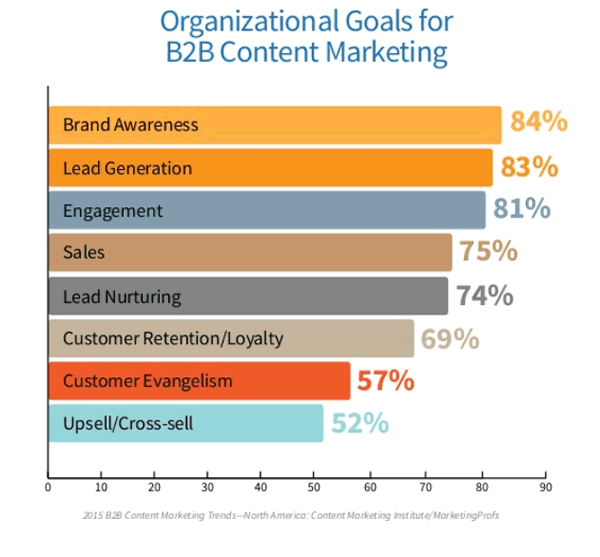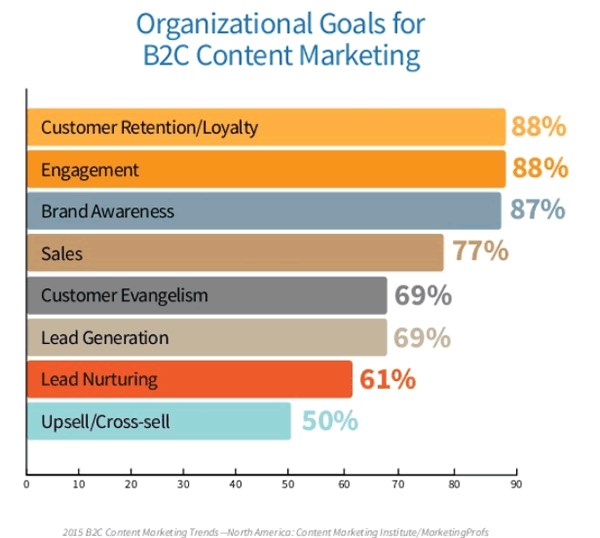
Content marketing is about using images, words, interactive applications, plain old information and other forms and formats of audience-centric (or customer-centric) and persuasive/engaging content to achieve marketing and business goals.
That’s the very simple view in which content marketing success is gauged by the outcomes (actions and results) and content is an object of human and social interaction and information in a marketing context.
The key ultimate goal of content marketing – and other “forms” of marketing – is to increase profit but the ways to do that have changed. The number of content formats people value has exploded. The days of using one channel to reach an audience are over. The ways customers inform themselves, buy, share and interact with each other have evolved.
Personal and personalized approaches and “relational” community-oriented strategies can go hand in hand with segmentation and more general views. Utterly customer-centric and individual strategies are further enabled in the data-driven marketing context of our big data age and in less automated and more human views (which is not the same as saying automation is bad, it all depends). And so, no “form of marketing, including content marketing, can be viewed in an isolated way, even if that’s still too often the case.
Just as content marketing can’t really be seen in an isolated way (it’s part of that bigger integrated marketing puzzle, essentially revolving around the customer and customer experience, in correlation with the brand’s value proposition), we really can’t isolate the marketing goals content marketing can fulfill.
We know content marketing is an umbrella term for a broad variety of tactics and techniques. It’s pervasive. That’s not because of content marketing (alone). It’s about the very old and simple fact that content (or information if you prefer, whatever form it takes), is essential in all communication and marketing.
When we talk about a strategic or planned approach to content marketing, we shouldn’t just look at content marketing techniques as such but also have a strategic view that goes beyond what we’ve come to call “content marketing”.
This doesn’t mean that you shouldn’t look at your content marketing strategy in the strict sense. What it does mean is that you need to look at all tactics and techniques when defining a (digital) marketing strategy.
Marketing goals and content marketing: think out of the box
Although specific forms and even formats and tactics in (digital) marketing are better suited to achieve specific goals (where the need to specialize comes in, in order to achieve these goals optimally), in general the individual marketing goals that can be achieved using content marketing overlap with those of many other tactics and marketing “forms” (where the need to have very customer-oriented generalists and strategists comes in).
Just look at (some of) the goals which you can serve using email marketing, for instance: are there any you can’t serve with content marketing?
Research aims to show us what marketing goals marketers serve using content marketing as you can see below but you’re totally free to think out of the box and do things differently than your peers of course. No one (should) know(s) your business and customers better than you (do you?). And there is ample room for trying out new stuff, making the difference, thinking out of the box and focus on your strengths and the needs and preferences of your customers and their influencers, connections, etc.
As content marketing expert Doug Kessler says content marketing is becoming mainstream. And you need to take a stand. This has an implication on the marketing goal level as well: look at it from a broader perspective and don’t just follow what others try to achieve.

You probably noticed some of the above mentioned organizational goals are not really marketing goals but rather intermediary goals. Engagement, for instance, can mean many things ‘en route’ to marketing goals.
Obviously, it’s nice to know what goals you can fulfil with content marketing and see what your peers try to achieve with it. But let’s face it: most organizations will start from their objectives, customers, priorities, current situation, realities, etc. and see how to achieve these goals. The latter part, the “how” and along with it the required resources, channels, tactics etc., are work for the digital marketing squad(s) and/or the digital marketing/strategy director (or any other operational marketing lead, depending on the business context).
Nevertheless, here are some goals/actions (mix of intermediary and others) you can use content marketing for, on top of everything else mentioned in this article:
- Educating/informing customers, partners and employees (fact: many contact center agents don’t know what content is on their organization’s website). It starts with making the most essential information available and can go all the way to channel enablement, partner enablement, employee enablement and the next “goal” and thus also includes essential content such as brochures and whatnot. At a specific point in time people want that too.
- Thought leadership. This is probably one of the vaguest intermediary goals around. However, by making viewpoints, knowledge and expertise about what audiences care about visible, it builds trust and and can make you a trusted advisor. Practice leadership and proven expertise trumps thought leadership in the strictest sense.
- Entertaining. You are not a publisher. However, by entertaining audiences, offering them content beyond the content they value most, various marketing goals can be served. We’re coming pretty close to engagement and branding here although entertaining through entertaining content can also be used for other goals. It’s not a goal as such but it can serve as one.
- Proving and overcoming objections. You don’t know what people are looking for when they first get in touch with your organization or content. Content can be used in all stages of the buying journey and for sales. Content that focuses on pain points encountered, leading to buying decisions, can include all types of content people might be looking for during that journey, including content that proves and overcomes potential objections.
- Sparking debate, interaction and community. The way people interact with content can lead to valuable insights and discussions, leading to new content and insights. Communities are not necessarily enabled around content and debate but they do thrive when they offer what people look for. Interaction and debate can be an element (remembering the fact the majority consists of lurkers) and information/content as well. Debate can be used for many goals, as can community marketing.
- Improving the customer experience and optimizing marketing efficiency. This, for us, is the most important and overlooked aspect. A lot of marketing goals served with content marketing revolve around the top and the bottom of the proverbial funnel. Fortunately, the importance of content for lead nurturing is growing in the eyes of many marketers. What is often missing though is a focus on what happens outside of the proverbial funnel and has to do with making the lives of customers easier (also when doing business with you), optimizing all your other marketing efforts from the customer perspective and improving the customer experience across each single piece of content and focusing on the middle and long term but also on low-hanging fruit and the massive leaks we find in virtually all customer-facing processes.
- Sales, partner and stakeholder enablement. We mentioned this earlier but it’s so often overlooked. The role of marketing is also to empower all stakeholders in the business process, from sales to partners and contact center reps so they have the material they need to do what they have to do. Just knowing where the right content sites and unlocking it in relevant ways using content management and information management processes and tools matters too, especially in an age of ever more information (what Big Data ultimately needs to result in: from data to information to insights to knowledge and process activation, including content analytics) and ever more unstructured data.
Content marketing goals and success: reversing the view
Just as we did in the earlier mentioned article about the marketing goals email marketing can serve, we would like you to reverse the view and look at the goals of your customers/audiences first and find the sweet spots where their goals and your goals meet as that is where the real value happens (again, taking into account the need to make a stand as a brand).
A marketing “relationship” – using content – is one that runs over a longer period of time, in correlation with the entire customer life cycle and – from a measurement perspective – the customer lifetime value. It can include short-term actions/tactics and it can take many years, content formats, techniques and touches. Just think about how the content created for tomorrow’s consumers of a brand, youngsters, can cause a shift of perception today that results in more business…tomorrow. This goes beyond the realm of content marketing but for virtually all forms of marketing.
A marketing “relationship” – using content – can also include many intermediary steps and goals (from short-term to long-term) such as growing a fan community, establishing a strong voice in any chosen topic, raising funds for a CSR initiative, engaging (as just mentioned a very broad concept) or building brand affinity. It is all connected too.
However, in the end, the ultimate goal of a business – and marketing – is to increase profit through all the well-known ways (and some lesser-known ways). If the profit is not there, there is nothing to do brilliant stuff with or to even pay employees. Pure and simple. Short-term, mid-term and long-term. Using more ‘direct’ techniques as in demand generation and less ‘direct’ techniques as in building loyalty and even advocacy through a multitude of initiatives and involving ‘the audiences’ – simply said, people – themselves.
Build your content marketing around mutual profit: for your business AND for your customers, in the broadest sense of profit and customers.
All the different “ways” of using content for marketing purposes – from custom publishing to search engine optimization, demand generation, etc. – are part of a puzzle to reach business goals by creating value for different audiences, regardless of the nature of that value (answers to pressing questions, solutions to challenges, the need to connect or just have plain old good fun). Again, it is all connected and plays – depending on your individual context – a key role towards content marketing success.

Know your customers: connected content marketing success as mutual profit
All the different typical elements in content marketing – from organization and planning to execution, optimization and measurement – are part of that same puzzle to achieve the different intermediary and final goals in tune with the intent, quests, needs and perceptions of the various audiences involved directly and indirectly.
The key in it all? Know your customers. Know what they want, need, like, value. Know what convinces them. Know what moves them. Ask them, measure it, find out, involve them. Build your content plan and content marketing strategy around it, in alignment with your brand’s value proposition as crystallized in its’ narrative, stories, (re)sources, brains, voices, ears and hearts, while striving for – mutual – profit: for your businesses and your customers, in the broadest possible sense of profit and customers.
Content marketing success and customer (experience) success are two sides of the same coin.
Once more, it is all connected ‘en route’ to overall marketing success. With a connected audience/customer/person at the center of it all because customer success is the best way to overall business success. Putting the customer first with a clear focus on invoking reactions through understanding and empathy and until that final reaction is reached and customer experience has been served.
Images purchased under license from Shutterstock

